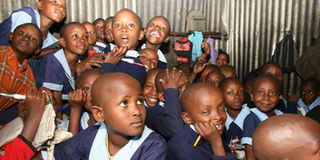Kenya making slow progress towards realisation of MDGs

PETERSON GITHAIGA | NATION: Pupils in a crowded class at the Better Life Community School situated at Nairobi's Mukuru Kwa Reuben during a lesson on 22 July 2010.
What you need to know:
- Indeed, in a few notable areas the report indicates that Kenya has actually lost ground”
John Harbeson
This week at the United Nations, the Heads of State of most of the world’s countries are reflecting on the extent of progress towards the realisation of eight key goals for reducing extreme poverty worldwide by 2015.
Adopted by world leaders with considerable fanfare in 2000, the measurement of most of the goals actually covers a 25-year time span rather than a 15-year frame of reference — from 1990 rather than 2000.
Overall, the goal is to cut poverty in all its major dimensions by 50 per cent. On balance, the leaders’ summit on the Millennium Development Goals (MDGs) concluded that progress has been mixed and prospects for reaching all the goals uneven.
They committed themselves to an action plan to accelerate progress toward the goals over the remaining five years of the project.
Governments with impoverished populations are not committed to realisation of the goals.
At the same time, donor countries haven’t met their financial commitments to the project.
And no one can be under any illusion about the inherent difficulty of meeting these goals.
But what have been the results of the MDG campaign for sub-Saharan Africa as a whole and for Kenya in particular?
There are eight goals, several specific targets for each goal, and numerous measurable indicators have been established to gauge progress toward these targets and the overall goals.
In general, data collated by the United Nations shows some significant progress in sub-Saharan Africa in many but not all areas. And Kenya has performed well by sub-Saharan Africa standards in many but not all areas.
Indeed, in a few notable areas the report indicates that Kenya has actually lost ground.
Eradicate extreme poverty
Goal number one is to eradicate extreme poverty and hunger. One measure of progress is the percentage of people in each country earning less than $1 a day. For sub-Saharan Africa as a whole, that percentage declined from 58 to 51 per cent between 1990 and 2005.
For Kenya, the percentage dropped from 38 per cent in 1992 to 20 per cent in 2005.
An important measure of chronic hunger is the percentage of children under five years of age who are underweight.
From 1990 to 2008, the percentage in sub-Saharan Africa decreased from 31 to 27. In Kenya, it dropped from 22.3 and 20.9 per cent.
The second goal is to achieve universal primary education. A key measure of progress toward this goal is the percentage of primary school aged children actually in school.
For sub-Saharan Africa, it increased sharply from 56 per cent in 1991 to 76 per cent in 2008. In Kenya, the percentages rose from 63 per cent in 1999 to 82 per cent in 2008.
Gender equality and the empowerment of women is MDG three. One key indicator of progress is gender equality in education at all levels. Female enrolment in primary school for the continent has increased from 84 per cent to 91 per cent.
Kenya’s numbers rose from 97 to 98 per cent.
Another measure is the percentage of women in parliament — sub-Saharan Africa registered a rise from 7.2 per cent in 1990 to 18.4 per cent in 2010. In Kenya, the percentage of women MPs increased from 1.1 to 9.8 per cent in the same period.
MDG four is to reduce child mortality by two-thirds. Mortality for children under five has reduced from 180 in 1990 to 144 per 1,000 births in sub-Saharan Africa, but this increased in Kenya from 105 to 128 in the same period.
Goal five is to reduce maternal mortality by three-fourths. For the region, limited progress has been made — from 920 per 100,000 in 1990 to 900 in 2008. Kenya’s figure in 2005 was 560.
Halting and reversing growth in HIV/AIDS, tuberculosis and malaria is the sixth goal. One HIV indicator is the percentage of adults with correct knowledge about prevention. In 2008, that figure stood at 33 per cent for men and 24 per cent for women in sub-Saharan Africa.
In Kenya, the percentage was higher at 47 per cent for men and 34 per cent for women.
Goal seven is environmental sustainability. The key measure here is the percentage of land under forest cover.
That dropped from 6.5 per cent in Kenya in 1990 to 6.2 per cent in 2010 — a fifth that for the region. The eighth goal is the development of a global partnership for development.
Overall, for Kenya and sub-Saharan Africa, there has been some progress, but not enough and not fast enough.



